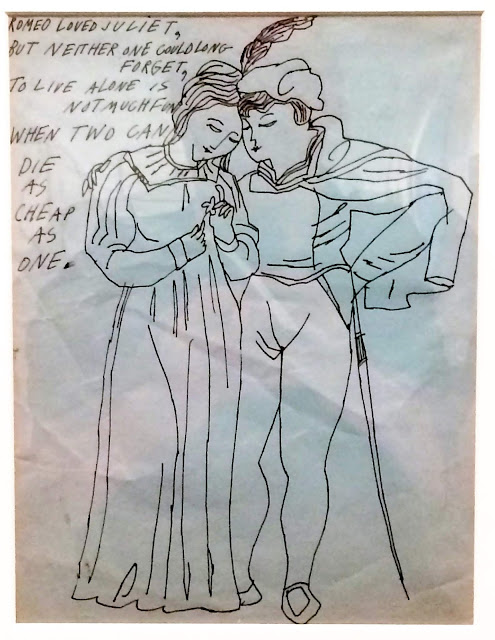During Year 3, we are living in D.C. and have focused most of our activities on the DMV.
Recently, however, we ventured outside the DMV and visited Susan's relatives in Ohio, near Akron. During the return trip, we stopped over in Pittsburgh to visit the Andy Warhol Museum.
Andy Warhol (born Andy Warhola in 1928) was a Pittsburgh native and is a favorite son. He spent his early life in Pittsburgh and received his artistic training there before moving to NYC in 1949, where he was in the vanguard of the Pop Art movement in the U.S. He died in 1987.
Following his death, Pittsburgh honored Andy Warhol by renaming a bridge in his honor and establishing a museum dedicated to his artwork.
Let's begin our tour. Below, Susan stands next to the Andy Warhol Bridge, which is located one block from the Andy Warhol Museum.
 |
| Susan next to the Andy Warhol Bridge over the Allegheny River, with downtown Pittsburgh in the background. |
 |
| Some dude standing in front of the Andy Warhol Museum. |
The Andy Warhol Museum (pictured below) is housed in the 7 story Frick & Lindsay building completed in 1911. The building has a well-preserved Beaux-Arts glazed terra cotta façade.
The museum's parking lot, across the street, is marked with an oversized version of Warhol's Brillo Pads (1966).
The museum is a comprehensive collection of Warhol's artwork, from childhood onward. Here are some early works from the 1950's, before Warhol became a leader of the Pop Art movement.
Below are some drawings by Warhol that were included in the book Love is a Pink Cake. The text accompanying each drawing is worth reading.
Because Susan loves shoes, she especially liked the work pictured below.
Next Up: Pop Art!
P.S. From NGA.gov, a bio of Andy Warhol: "Fascinated by consumer culture, the media, and fame, Andy Warhol himself became one of the most famous and important artists of the twentieth century.
The son of Czechoslovakian immigrants, Andrew Warhola grew up in Pittsburgh, Pennsylvania, studying art at the Carnegie Institute of Technology from 1945 to 1949. Soon after graduating he moved to New York City, where he abbreviated his name to Andy Warhol and began working as a commercial designer and window display artist, winning several awards for his distinctive advertising designs. At the same time, he was developing his own style of painting, which was inspired by mass culture, a subject that riveted the artist and dominated his entire oeuvre. By the early 1960s, Warhol's paintings of dollar bills, soup cans, and movie stars established his status as the founder of pop art. Repetition was a key to Warhol's work, as evidenced by his many recurrent series which included flowers, Marilyn Monroe, Jacqueline Kennedy Onassis, and Chairman Mao, among others. Warhol deliberately infused his work with a mechanical and impersonal character that intensified when he adopted silkscreen printing techniques in order to increase his production. To accelerate this process even further, he employed a large group of assistants in his studio, dubbed "The Factory." This practice brilliantly reflected the commercial, industrial economy of the mechanical reproduction age.
Warhol was also a popular and influential figure in the underground film movement; his documentary approach often focused on banal and repetitive subject matter. In the 1970s he shifted his attention back to painting portraits of famous people, mainly working on commission. Warhol's bland persona, platinum wig, and public statements such as, "In the future everybody will be world-famous for 15 minutes," epitomized the underground culture of the 1960s and 1970s. In 1975 he published The Philosophy of Andy Warhol. During the 1980s Warhol often collaborated with younger artists, including Jean-Michel Basquiat and Francesco Clemente. His flamboyant career was suddenly cut short in 1987 when he died of complications after gall bladder surgery."













No comments:
Post a Comment